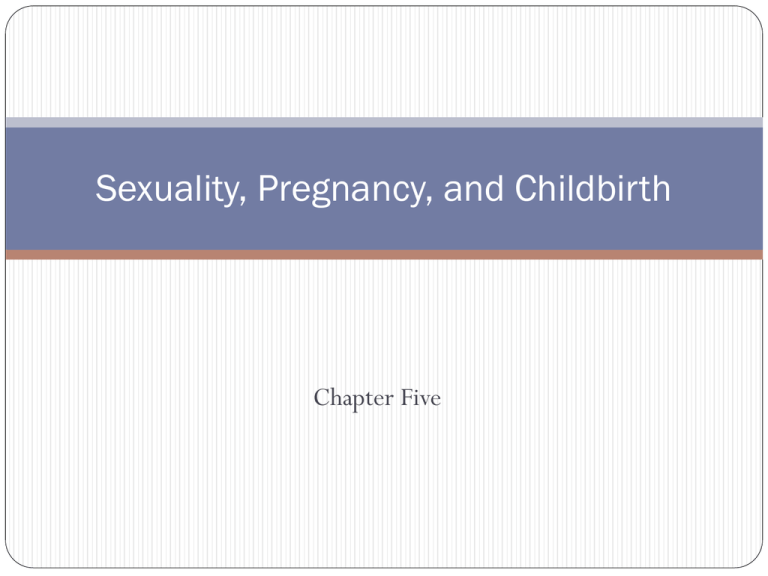
Sexuality, Pregnancy, and Childbirth
Chapter Five
Sexual Anatomy
External Female Genitals
Internal Female Genitals
(Vulva)
Uterus
Mons pubis
Endometrium
Labia majora
Cervix
Labia minora
Ovaries
Prepuce
Fallopian tubes
Clitoris
Hymen
Urethral opening
Vagina
2
© 2010 McGraw-Hill Companies. All Rights Reserved.
Figure 5-1 The Female sex organs
3
© 2010 McGraw-Hill Companies. All Rights Reserved.
Reproductive Anatomy
Male Sex Organs: Two components
Penis
The Glans
Corpus spongiosum
Scrotum
4
Function (Temperature 93.6 degrees F)
Testes
Epididymis
Seminiferous tubules within the Testes
Vas Deferens
Prostate
Cowper’s glands
Seminal vesicle
© 2010 McGraw-Hill Companies. All Rights Reserved.
Figure 5-2 The male sex organs
5
© 2010 McGraw-Hill Companies. All Rights Reserved.
Hormones and The Reproductive Life
Cycle
Hormones: Endocrine glands
Androgens
Testes produce androgens - testosterone
Ovaries produce estrogen and progesterone
Cortex of the Adrenal gland produces androgens in both males
and females
Pituitary gland
Hypothalamus
6
© 2010 McGraw-Hill Companies. All Rights Reserved.
Differentiation of the Embryo
Determined by a interaction of genetic, physiological and
environmental factors.
Conception - combining of 23 pairs of chromosomes
22 are the same and the twenty-third is the sex chromosomes.
Egg carries an X sex chromosome.
Sperm carries either a X or Y chromosome.
XX provides the blueprint to produce a female.
XY provides the blueprint to produce a male.
7
© 2010 McGraw-Hill Companies. All Rights Reserved.
Female Sexual Maturation
Begins around 8-13 with breast development and rapid body
growth between 9 and 15.
Physical maturation.
Breast development
Rounding of the hips and buttocks
Hair growth in pubic region and arm pits
The Menstrual Cycle - four phases.
Menses.
Days 1-5
Estrogenic phase.
Days 6-13
Ovulation phase.
Day 14
Progestational phase.
Days 15-27
8
© 2010 McGraw-Hill Companies. All Rights Reserved.
9
© 2010 McGraw-Hill Companies. All Rights Reserved.
Menstrual Problems
Dysmenorrhea (the occurrence of painful cramps during
menstruation)
Some symptoms caused from prostaglandins (fatty acids)
Premenstrual syndrome (PMS)
A collection of physical, psychological, and emotional symptoms related to a
woman's menstrual cycle.
Premenstrual Dysphoric disorder (PMDD)
A collection of physical and emotional symptoms that occurs 5 to 11 days
before a woman's period begins, and goes away once menstruation starts.
Lifestyle changes to reduce symptoms:
10
Limit salt intake
Exercise
Don’t use alcohol or tobacco
Eat a nutritious diet
Relax
If systems persist, keep a daily diary
© 2010 McGraw-Hill Companies. All Rights Reserved.
Male Sexual Maturation
2 years later than girls
Begins about 10 or 11 years old
Physical changes.
Testicular growth
Penis growth
Pubic hair growth
Voice deepens
11
© 2010 McGraw-Hill Companies. All Rights Reserved.
Aging and Human Sexuality
Menopause
Ovaries gradually cease functioning
Decreasing estrogen
Increase risk of disease
Males
Gradual decrease of testosterone
12
© 2010 McGraw-Hill Companies. All Rights Reserved.
Sexual Function
Sexual stimulation
Comes from both physical and psychological stimuli
Physical stimulation
Through the senses
Erogenous zones
Psychological stimulation
Fantasies
Ideas
Memories of past experience
Mood
13
© 2010 McGraw-Hill Companies. All Rights Reserved.
Sexual Response Cycle
Physiological mechanisms
Vasocongestion (increase blood flow to the tissues)
Myotonia (muscle tension)
Four phases Characterize the sexual response cycle
Excitement phase
2. Plateau phase
3. Orgasmic phase
1.
4.
14
Males (refractory phase)
Resolution phase
© 2010 McGraw-Hill Companies. All Rights Reserved.
Sexual Problems
Common Sexual Health Problems
Biological and psychological conditions:
Women:
Vaginitis
Candida (yeast infection)
Trichomonas (genital and urinary tract infection)
Endometriosis (uterine lining develops or grows in other parts of the body)
Pelvic Inflammatory Disease (PID)
any infection in the lower female reproductive tract that spreads to the
upper female reproductive tract
50-75% of PID cases are caused by STDs
Men:
Prostatitis (inflammation of the prostate gland)
Testicular cancer
15
Most common in men in their twenties and thirties.
© 2010 McGraw-Hill Companies. All Rights Reserved.
Sexual Dysfunctions
Common sexual dysfunctions:
Male –
erectile dysfunction
premature ejaculation
retarded ejaculation
Women –
orgasmic dysfunction
Treatment
Psychosocial - troubled relationships
Behavioral
Relaxation and massage techniques
16
© 2010 McGraw-Hill Companies. All Rights Reserved.
Sexual Behavior
The development of sexual behavior
Gender roles and gender identity
Gender role is everything you do in your daily life that expresses your
maleness or femaleness as defined by society.
State of being male or female
Transsexual – those that feel that their biological sex does not match their
gender identity.
Transvestites – wearing clothing identified with the other gender.
Intersexed –born with ambiguous genitals – neither fully female nor fully
male.
Biological and cultural influences
Gender-role flexibility
17
© 2010 McGraw-Hill Companies. All Rights Reserved.
Responsible Sexual Behavior
Careful decision making
Open, honest communication about intentions
Agreed-On sexual activities
Sexual privacy
The use of Contraception
Safer sex
Sober sex
Taking responsibility for the consequences
18
© 2010 McGraw-Hill Companies. All Rights Reserved.
Understanding Fertility
Conception
Involves the fertilization of a women’s egg by a man’s sperm
Each month a women’s ovaries release an egg
24 hours if not fertilized
3-4 days - the egg travels through the fallopian tubes
Egg not fertilized
Millions of sperm
Sperm release an enzyme
Egg and sperm each carry 23 chromosomes
Ovum, blastocyst, embryo, fetus
Fraternal twins and identical twins
19
© 2010 McGraw-Hill Higher Education. All rights reserved.
20
© 2010 McGraw-Hill Higher Education. All rights reserved.
Female infertility
Infertility
One of two key causes
Tubal blockage (40%)
Failure to ovulate (40%)
Blocked Fallopian tubes are most commonly caused by pelvic inflammatory
disease (PID)
Chlamydia or gonorrhea
Endometriosis
21
© 2010 McGraw-Hill Higher Education. All rights reserved.
Infertility
Male infertility
Accounts for about 20% of infertile couples
Four main categories
22
Hypothlamic pituitary disease
Congenital disorders (abnormality of the human body)
Testicular disease
Disorders of sperm
© 2010 McGraw-Hill Higher Education. All rights reserved.
Infertility Treatment
Intrauterine insemination
Artificial intrauterine insemination - the hoped-for outcome of intrauterine
insemination is for the sperm to swim into the fallopian tubes and fertilize a
waiting egg, resulting in pregnancy.
IVF,GIFT, and ZIFT
In vitro fertilization (IVF) - fertilized egg in lab inserted into uterus
Gamete intrafallopian transfer (GIFT) - insertion of eggs and sperm into
fallopian tube)
Zygote intrafallopian transfer (ZIFT) - fertilized egg (zygote or embryo)
inserted into fallopian tube
Surrogate Motherhood
23
© 2010 McGraw-Hill Higher Education. All rights reserved.
Pregnancy
3 periods of about 3 months (13 week trimesters)
Tests
Home pregnancy tests
Human chorionic gonadotropin (HCG)
Two weeks after fertilization
Early signs and symptoms
Missed menstrual period
Softening of the uterus
Hager’s sign
Slight bleeding
Nausea
Breast tenderness
Increased urination
Sleepiness, fatigue and emotional upset
24
© 2010 McGraw-Hill Higher Education. All rights reserved.
25
© 2010 McGraw-Hill Higher Education. All rights reserved.
Continual Change in the Women’s
Body
Uterus size
First 3 months, the uterus enlarges to about three times its
nonpregnant size
4th month, large enough to make abdominal protrude
7th-8th month, pushes up into the rib cage
Breast changes
8th week
10th week
Colostrum (breast milk)
Muscles and Ligaments loosen
Weight Gain
26
© 2010 McGraw-Hill Higher Education. All rights reserved.
Changes During the Later Stages of
Pregnancy
Increased needs placed on the mother.
Braxton hicks contractions.
Lightening (“dropping”)
Emotional responses to Pregnancy.
27
© 2010 McGraw-Hill Higher Education. All rights reserved.
28
© 2010 McGraw-Hill Higher Education. All rights reserved.
Fetal Development
First Trimester
Blastocyst
Inner cells divide into three layers
One layer – inner body parts
Middle layer – muscle, bone, blood, kidneys, and sex glands
Third layer – skin, hair, and nervous tissue
Embryo - End of second week
All major body structures are formed between 2nd and 9th week
2nd Month - Fetus
29
© 2010 McGraw-Hill Higher Education. All rights reserved.
30
© 2010 McGraw-Hill Higher Education. All rights reserved.
Fetal Development
Second Trimester
Fetus grows to about 14 inches and 2 pounds
Third Trimester
Fetus gains protective fat layers, Respiratory and Digestive
organs develop
31
© 2010 McGraw-Hill Higher Education. All rights reserved.
32
© 2010 McGraw-Hill Higher Education. All rights reserved.
The Importance of Prenatal Care
Regular medical checkups
Blood tests
Prenatal nutrition
Avoidance of drugs, and other environmental hazards:
Teratogens (an agent, such as a virus, a drug, or radiation, that
causes malformation of an embryo or fetus)
1st trimester
Congenital malformations (e.g., birth defects)
33
Alcohol
Tobacco
Caffeine
Drugs
STD’s and other infections
© 2010 McGraw-Hill Higher Education. All rights reserved.
Diagnosing Fetal Abnormalities
Ultrasonography (Ultrasound)
High frequency sound waves
Amniocentesis
Fluid removal from the uterus
Chorionic Villus (CVS) sampling
Removal of tiny section of chorionic villi
Quadruple marker screen (TMS)
Maternal blood test
Analyze four hormone levels and compared to appropriate standards
34
© 2010 McGraw-Hill Higher Education. All rights reserved.
The Importance of Prenatal Care
Activity and exercise
Moderate exercise program
30 minutes most days
Cardiovascular exercises
Kegal Exercises
Prenatal exercise classes
Preparation for childbirth
35
© 2010 McGraw-Hill Higher Education. All rights reserved.
Complications of Pregnancy and Pregnancy Loss
Ectopic pregnancy
Spontaneous Abortion, or miscarriage
Stillbirth
Preeclampsia/eclampsia
Placenta Previa (a condition that occurs during pregnancy when the placenta is abnormally
placed, and partially or totally covers the cervix)
Placental Abruption (occurs when the placenta separates from the wall of the uterus prior
to the birth of the baby. This can result in severe, uncontrollable bleeding or hemorrhage)
Gestational Diabetes
Preterm Labor
Labor Induction
Low-birth Weight (LBW)
5.5 LBS.
Infant Mortality
SIDS
36
© 2010 McGraw-Hill Higher Education. All rights reserved.
Childbirth
Choices in childbirth
Who is going to assist with delivery?
Physician
Certified Nurse-Midwife
Where is the baby going to be delivered?
Hospital
Home
37
© 2010 McGraw-Hill Higher Education. All rights reserved.
Labor and Delivery
Entire process 2-36 hours.
First stage of Labor.
Average13 hours for a first birth.
Cervix is completely dilated (10 centimeters)
Hormonal changes.
Contractions. (30 seconds and occur every 15-20 minutes)
Mucus plug is expelled and amniotic sac may rupture.
Transition:
Contractions may last 60-90 seconds and be 1-3 minutes apart
38
© 2010 McGraw-Hill Higher Education. All rights reserved.
Childbirth
Second Stage of Labor
Baby slowly pushed into birth canal
Baby squeezes through pelvis
Head is usually delivered first; “crowning”
Third Stage of Labor
Delivery of the placenta
Stage typically lasts 5-30 minutes
Apgar Scale of the Baby
Heart rate
Respiration
Color
Reflexes
Muscle tone
Total score is between 0 and 10
39
© 2010 McGraw-Hill Higher Education. All rights reserved.
40
© 2010 McGraw-Hill Higher Education. All rights reserved.
Pain Relief During Labor and Delivery
Childbirth preparation courses
Breathing and relaxation techniques
Lamaze or Bradley
Epidural (e.g., anesthesia to numb
abdomen and legs)
Narcotics
Fentanyl or demeral
Provide less pain relief than a epidural
41
© 2010 McGraw-Hill Higher Education. All rights reserved.
Cesarean Deliveries
2006 about 31.1% of babies born in the U.S.
Surgical removal of the baby
Baby’s head too large
Mother has a serious health condition
Mother who is overweight or diabetes
Difficult labor
Fetal distress
Dangerous infections
90% of cesarean mothers will have subsequent deliveries by cesarean
42
© 2010 McGraw-Hill Higher Education. All rights reserved.
Chapter 5 Connect Assignment Due
Tuesday, February
43
th
9
© 2010 McGraw-Hill Companies. All Rights Reserved.






